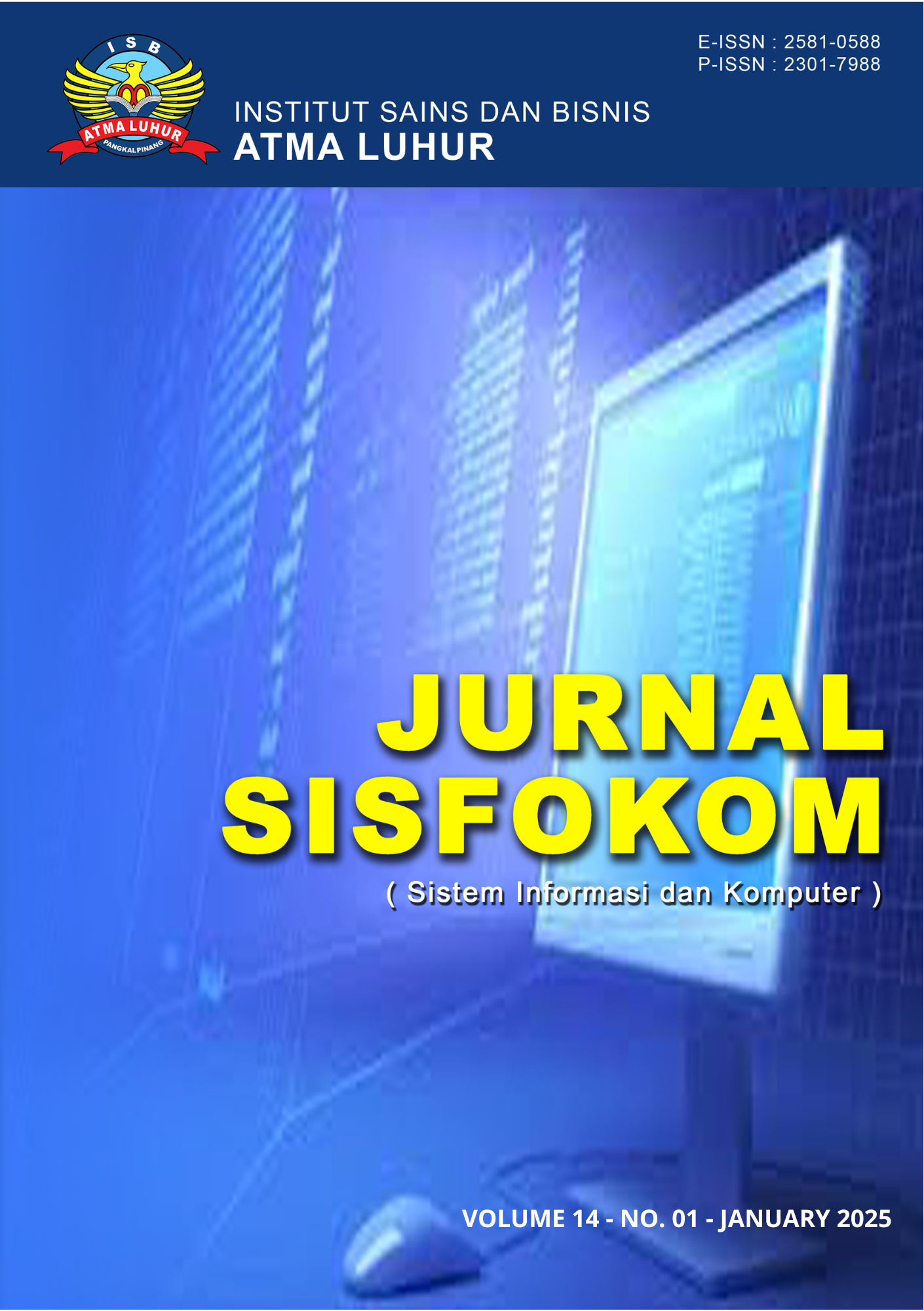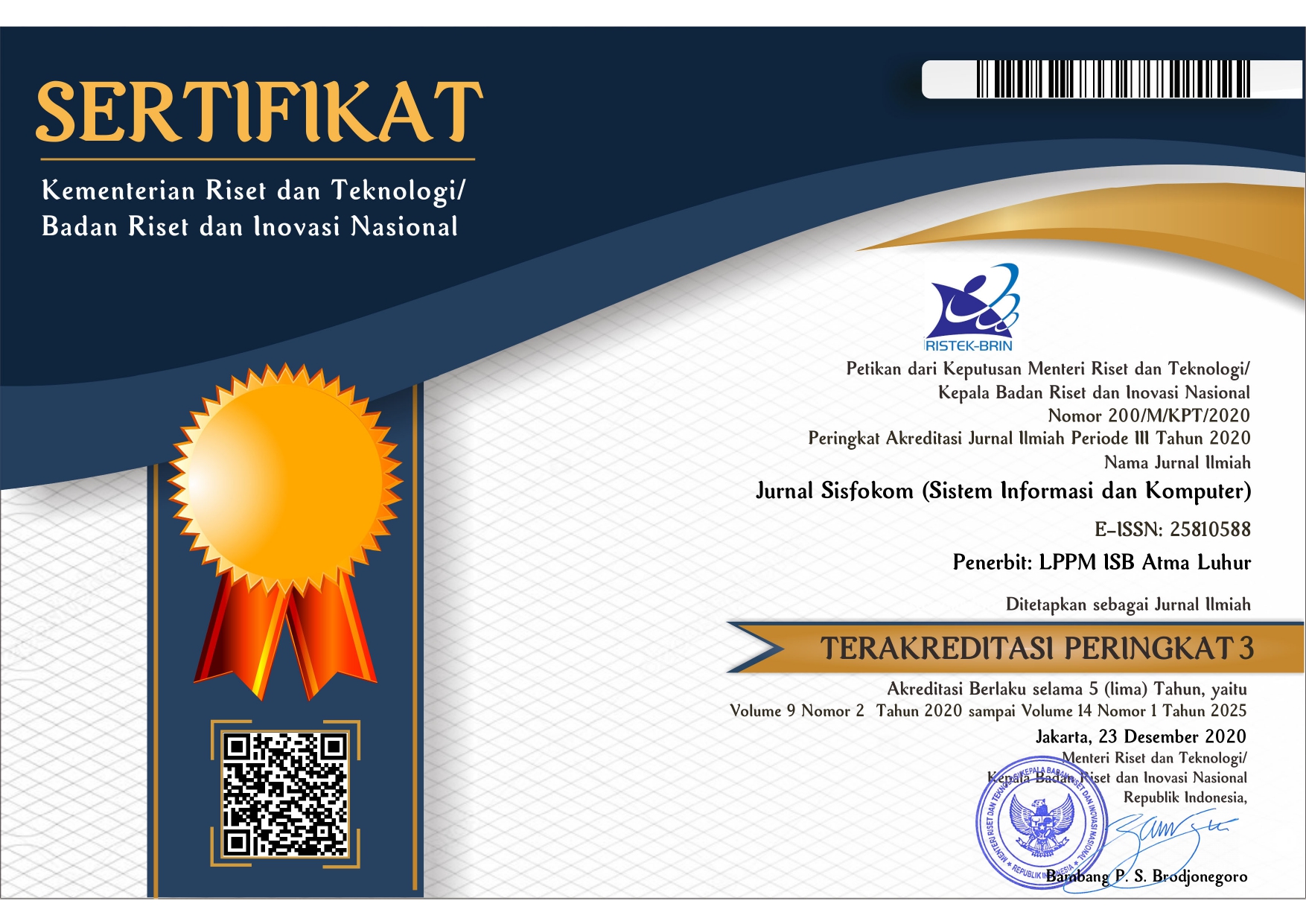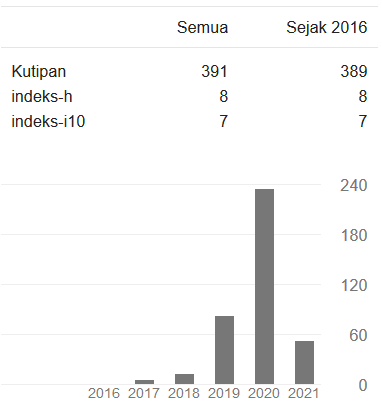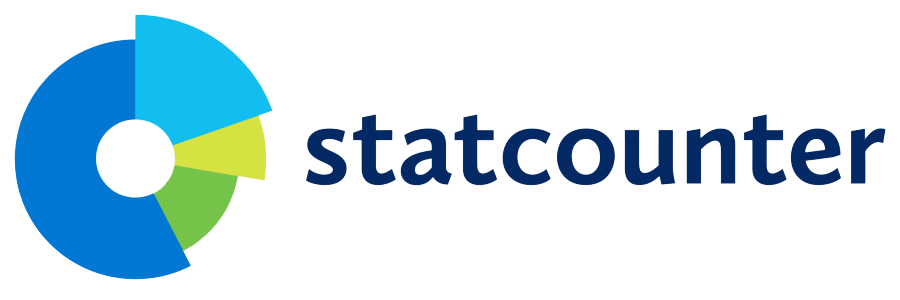Comparison of the Performance of the C.45 Algorithm with Naive Bayes in Analyzing Book Borrowing at the Library Pringsewu Muhammadiyah University
DOI:
https://doi.org/10.32736/sisfokom.v14i1.2300Keywords:
Book Borrowing Patterns, C4.5, Naive Bayes, Datamining, Machine LearningAbstract
This study examines the effectiveness of the Naïve Bayes and C4.5 algorithms in analyzing book borrowing patterns at the Pringsewu Muhammadiyah University Library. As libraries increasingly serve as vital educational hubs, understanding user borrowing behavior is essential for effective collection management and service enhancement. The research follows the Cross-Industry Standard Process for Data Mining (CRISP-DM), which includes stages of business understanding, data understanding, preparation, modeling, evaluation, and implementation. A dataset consisting of 5,586 records and ten attributes related to book lending was utilized, with comprehensive data cleaning and preprocessing conducted. The performance of both algorithms was assessed using K-fold cross-validation, yielding an accuracy of 96.26% for C4.5, compared to 91.44% for Naïve Bayes. These results demonstrate that C4.5 is more adept at capturing complex relationships within the data, providing deeper insights into user preferences and enhancing library services. This research underscores the potential of data mining techniques to optimize library management and proposes avenues for future investigation, such as exploring advanced machine learning algorithms and expanding datasets for use in broader library contexts.References
L. Yulita, A. S. Sunge, and N. Nurhidayanti, “Optimasi Algoritma Genetika Dalam Memprediksi Minat Baca Siswa Pada Perpustakaan SMK Negeri 1 Gantar Dengan Metode Decision Tree.”
E. Irfiani, Y. Kusnadi, S. Sunarti, and F. Handayanna, “Implementasi Data Mining dalam Mengklasifikasi Minat Baca Pada Perpustakaan Daerah Menggunakan Algoritma C4.5,” JOINS (Journal of Information System), vol. 8, no. 2, pp. 106–114, Nov. 2023, doi: 10.33633/joins.v8i2.8004.
T. T. Sang Nguyen, “Model-based book recommender systems using Naïve Bayes enhanced with optimal feature selection,” in ACM International Conference Proceeding Series, Association for Computing Machinery, 2019, pp. 217–222. doi: 10.1145/3316615.3316727.
L. Feng, “Research on Higher Education Evaluation and Decision- Making Based on Data Mining,” Sci Program, vol. 2021, 2021, doi: 10.1155/2021/6195067.
D. Berrar, “Bayes’ Theorem and Naive Bayes Classifier,” in
Encyclopedia of Bioinformatics and Computational Biology, S.
Ranganathan, M. Gribskov, K. Nakai, and C. Schönbach, Eds., Oxford: Academic Press, 2019, pp. 403–412. doi: https://doi.org/10.1016/B978-0-12-809633-8.20473-1.
J. Moolayil, Learn Keras for Deep Neural Networks. Apress, 2019. doi: 10.1007/978-1-4842-4240-7.
S. Xuanyuan, S. Xuanyuan, and Y. Yue, “Application of C4.5 Algorithm in Insurance and Financial Services Using Data Mining Methods,” Mobile Information Systems, vol. 2022, 2022, doi: 10.1155/2022/5670784.
X. Xiongjun and D. Lv, “The Evaluation of Music Teaching in Colleges and Universities Based on Machine Learning,” Journal of Mathematics, vol. 2022, 2022, doi: 10.1155/2022/2678303.
S. and Communication Networks, “Retracted: Analysis and Application of Data Mining Technology for College English Education Integration,” Security and Communication Networks, vol. 2024, pp. 1–1, Jan. 2024, doi: 10.1155/2024/9836129.
W. Liu et al., “Using a classification model for determining the value of liver radiological reports of patients with colorectal cancer,” Front Oncol, vol. 12, Nov. 2022, doi: 10.3389/fonc.2022.913806.
P. V. Ngoc, C. V. T. Ngoc, T. V. T. Ngoc, and D. N. Duy, “A C4.5
algorithm for english emotional classification,” Evolving Systems, vol. 10, no. 3, pp. 425–451, Sep. 2019, doi: 10.1007/s12530-017-
9180-1.
J. Wang, “Application of C4.5 Decision Tree Algorithm for Evaluating the College Music Education,” Mobile Information Systems, vol. 2022, 2022, doi: 10.1155/2022/7442352.
Y. A. Alsariera, Y. Baashar, G. Alkawsi, A. Mustafa, A. A. Alkahtani, and N. Ali, “Assessment and Evaluation of Different Machine Learning Algorithms for Predicting Student Performance,” 2022, Hindawi Limited. doi: 10.1155/2022/4151487.
X. Yang and J. Ge, “Predicting Student Learning Effectiveness in Higher Education Based on Big Data Analysis,” Mobile Information Systems, vol. 2022, 2022, doi: 10.1155/2022/8409780.
Parteek Bhatia, “Data Mining and Data Warehousing,” 2019.
B. Mahesh, “Machine Learning Algorithms - A Review,”
International Journal of Science and Research (IJSR), vol. 9, no. 1, pp. 381–386, Jan. 2020, doi: 10.21275/art20203995.
T. Sinta Peringkat et al., “Komparasi Algoritma Decision Tree, Naive Bayes Dan K-Nearest Neighbor Untuk Memprediksi Mahasiswa Lulus Tepat Waktu,” 2020, [Online]. Available: www.bri- institute.ac.id
S. Alim, “Implementasi Orange Data Mining Untuk Klasifikasi Kelulusan Mahasiswa Dengan Model K-Nearest Neighbor, Decision Tree Serta Naive Bayes Orange Data Mining Implementation For Student Graduation Classification Using K-Nearest Neighbor, Decision Tree And Naive Bayes Models,” 2021.
D. Lianda and N. Surya Atmaja, “Prediksi Data Buku Favorit Menggunakan Metode Naïve Bayes (Studi Kasus: Universitas Dehasen Bengkulu),” 2021. [Online]. Available: www.ejournal.unib.ac.id/index.php/pseudocode
Nurmalitasari, Z. Awang Long, and M. Faizuddin Mohd Noor, “Factors Influencing Dropout Students in Higher Education,” Educ Res Int, vol. 2023, 2023, doi: 10.1155/2023/7704142.
S. A. Alwarthan, N. Aslam, and I. U. Khan, “Predicting Student Academic Performance at Higher Education Using Data Mining: A Systematic Review,” 2022, Hindawi Limited. doi: 10.1155/2022/8924028.
Downloads
Published
Issue
Section
License
Copyright (c) 2025 Jurnal Sisfokom (Sistem Informasi dan Komputer)

This work is licensed under a Creative Commons Attribution 4.0 International License.
The copyright of the article that accepted for publication shall be assigned to Jurnal Sisfokom (Sistem Informasi dan Komputer) and LPPM ISB Atma Luhur as the publisher of the journal. Copyright includes the right to reproduce and deliver the article in all form and media, including reprints, photographs, microfilms, and any other similar reproductions, as well as translations.
Jurnal Sisfokom (Sistem Informasi dan Komputer), LPPM ISB Atma Luhur, and the Editors make every effort to ensure that no wrong or misleading data, opinions or statements be published in the journal. In any way, the contents of the articles and advertisements published in Jurnal Sisfokom (Sistem Informasi dan Komputer) are the sole and exclusive responsibility of their respective authors.
Jurnal Sisfokom (Sistem Informasi dan Komputer) has full publishing rights to the published articles. Authors are allowed to distribute articles that have been published by sharing the link or DOI of the article. Authors are allowed to use their articles for legal purposes deemed necessary without the written permission of the journal with the initial publication notification from the Jurnal Sisfokom (Sistem Informasi dan Komputer).
The Copyright Transfer Form can be downloaded [Copyright Transfer Form Jurnal Sisfokom (Sistem Informasi dan Komputer).
This agreement is to be signed by at least one of the authors who have obtained the assent of the co-author(s). After submission of this agreement signed by the corresponding author, changes of authorship or in the order of the authors listed will not be accepted. The copyright form should be signed originally, and send it to the Editorial in the form of scanned document to sisfokom@atmaluhur.ac.id.









